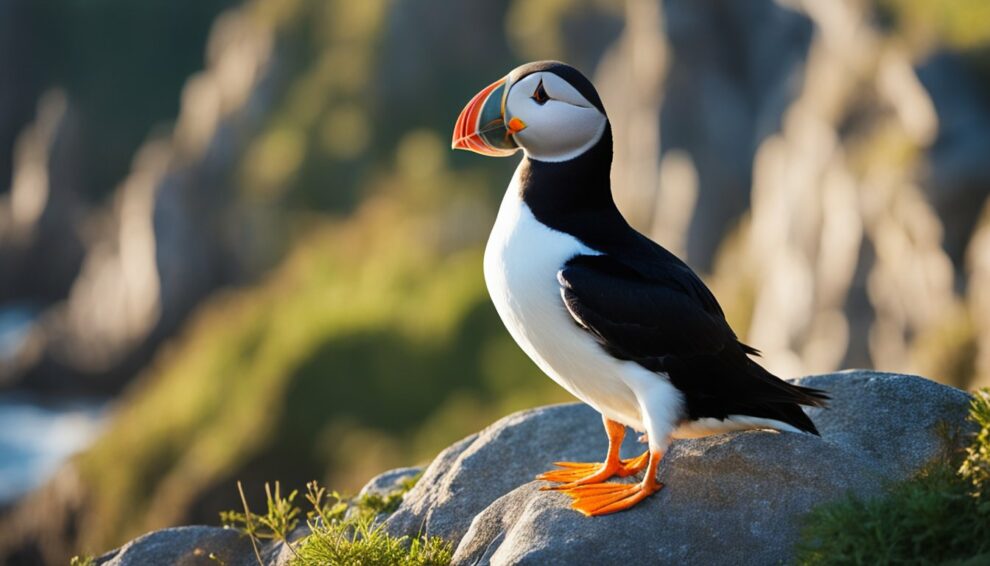The Atlantic Puffin, with its iconic black and white feathers and kaleidoscopic beak, might resemble a parrot of the seas to the imaginative onlooker.
These seabirds are much more than just their striking appearance; they are masters of the marine world, particularly when it comes to securing their favorite meal—fish.
Their fishing methods are a marvel of the natural world and a clear testament to the intricacies of wildlife behaviors developed over eons.

During the breeding season, these seabirds can be spotted on cliffside colonies in the North Atlantic, where their fishing skills are put to the test.
Unlike many birds that may simply swoop down to snatch their prey from the water, puffins employ a more remarkable strategy.
Their wings, adapted for both air and sea, transform into powerful flippers underwater, propelling them through the ocean’s depths.
They dart with agility and precision to capture small fish one by one, using their uniquely shaped bills to hold multiple fish crosswise during a single dive.
But these actions aren’t just for show; they play a critical role in the survival of puffins and their chicks.
Puffin parents work tirelessly, foraging for fish to feed their hungry offspring waiting in burrows on the shore.
Their success is not only a display of individual prowess but is also pivotal for the conservation of their species.
Amidst the ocean’s currents and tides, Atlantic puffins continue to demonstrate what it means to thrive in a challenging ecosystem—raising curiosity and admiration for one of Earth’s remarkable avian fishers.
Physical Characteristics of the Atlantic Puffin
The Atlantic Puffin is a striking seabird known for its vivid features that are perfectly suited to its marine lifestyle.
Its unique adaptations are a spectacle of nature’s design.
Unique Features and Adaptations
Adorned in black and white feathers, the Atlantic Puffin exhibits a stark contrast that aids in both mating rituals and camouflage from predators.
They have evolved a rotund body with short wings that flap vigorously during flight, allowing these seabirds to become adept fliers as much as they are swimmers.
The puffin’s most iconic trait is its colorful beak, which is not only a brilliant orange but also serves as a powerful tool for fishing.
The beak’s serrated edges help the puffin grasp multiple fish at once, maximizing its haul with each dive.
Its sturdy legs, positioned towards the rear of its body, propel it through water with grace and efficiency.
Color Changes Throughout the Year
Throughout the year, the puffin’s appearance undergoes a fascinating transformation.
In the breeding season, their beak and feet brighten to an intense orange, enticing potential mates with this colorful display.
But did you know that after the breeding season, the outer parts of their bill are shed, revealing a smaller and duller beak underneath?
Their feathers also molt, and as winter approaches, the puffin’s face becomes grayer and their plumage less vibrant, blending more seamlessly with the winter sea.
These seasonal color changes are a wonderful example of how nature equips its creatures to thrive in changing environments.
Breeding Habits and Lifecycle

The Atlantic Puffin has a fascinating breeding lifecycle that starts with mate selection and progresses through to the rearing of their pufflings.
During their breeding season, puffins return to coastal cliffs and islands to form breeding colonies.
Let’s explore how these seabirds find their partners and raise their young.
Selecting Mates and Nesting Sites
When it’s time for breeding, typically in late spring or early summer, Atlantic Puffins reunite at their breeding colonies, often returning to the same burrow they used in previous years.
Nesting sites are usually on steep cliffs with grassy crevices or on islands with suitable soil for burrowing.
Puffins form long-term pair bonds, and they reinforce these bonds with elaborate greetings like billing, where they rub their colorful beaks together.
Building a cozy home, puffins dig out burrows with their powerful feet or utilize natural crevices.
These burrows, which can be up to several feet deep, serve as protection for the single egg they will lay and later for the chick.
The preference for burrows keeps their young out of sight from predators, enhancing their survival prospects.
Egg Laying and Chick Rearing
Once the nesting site is secured and prepared, the female Atlantic Puffin lays a single egg.
Both parents share the incubation duties for roughly six weeks.
The protective parents keep the egg warm and safe until it hatches, unveiling a puffling.
After hatching, puffin chicks, called pufflings, are nurtured in the burrow by both parents for roughly another six weeks.
They need a lot of food to grow strong, so their parents might make multiple fishing trips every day. Have you ever seen someone juggle?
Imagine a puffin parent juggling, not balls, but dozens of fish at a time, carrying them back to the hungry chick!
Once the pufflings are strong enough and their flight feathers have developed, they leave the burrow under cover of darkness.
This stage is known as fledging.
It marks their first brave step into the ocean and the beginning of their life at sea.
Survival during these initial stages is critical, and the fledging success contributes to the population’s reproduction rates.
The Atlantic Puffin’s lifecycle continues the next year when they mature and return to the cliffs to find a mate and start their own family.
Isn’t it wondrous how the cycle of life continues in the avian world?
Puffin Diets and Fishing Techniques

The Atlantic Puffin is a master at fishing, depending heavily on certain fish species to nourish its young.
This section uncovers how puffins catch their prey and the diet that sustains their chicks.
Diving and Catching Prey
Puffins are excellent divers and utilize a “fly underwater” technique to capture fish.
They propel themselves using their wings while steering with their feet.
When foraging, puffins target small fish like herring, sand eels, and capelin, which are abundant in their habitat.
Success in catching prey is crucial for their survival, as it affects their ability to breed and maintain their population.
Predation also plays a role, as puffins must evade predators to ensure they provide enough food sources for themselves and their offspring.
Feeding the Chicks
Once puffins secure their prey, they transport the fish to their chicks.
An Atlantic Puffin can carry multiple fish crosswise in its beak, thanks to a unique hinging mechanism that allows it to open its mouth while retaining the catch.
The diet of puffin chicks mainly comprises of the same small fish their parents eat, particularly herring, sand eels, and capelin.
The delivery of food is frequent during the chick-rearing phase, signaling the parents’ relentless effort to maximize the feeding success and survival of their young.
Threats to Puffin Populations and Conservation Efforts

The Atlantic Puffin is a resilient bird but faces several threats that challenge its survival.
From changes in the ecosystem to direct dangers from human activities, this section explores the key challenges and the conservation measures aimed at protecting these seabirds.
Natural Predators and Human Impact
Atlantic Puffins are part of a delicate marine ecosystem where they encounter various natural predators such as gulls and skuas, which target puffin chicks and eggs.
But have you ever wondered just how much human actions add to their troubles?
Human-induced climate change is altering the seas, affecting fish stocks, the main food source for puffins.
Factors like overfishing further deplete these fish populations.
Did you know that pollution, such as oil spills, can be disastrous for the waterproofing and insulation of puffin feathers?
This leads to a decrease in survival rates.
In the busy waters of the North Atlantic, the risk of puffins getting accidentally caught in fishing nets is a grim reality.
With the Atlantic Puffin population being termed vulnerable and some areas classifying them as endangered or even critically endangered, it’s clear they need protection to prevent their numbers from plummeting.
Efforts to Protect Puffin Habitats
Imagine a world without these colorful-beaked birds – it’s not a world we want, right?
So, to protect their habitats, conservation groups have been working tirelessly.
Protecting the nesting grounds is crucial, as this is where puffins raise their young, called pufflings.
By creating and maintaining marine protected areas, conservationists are securing spaces where puffins can feed and breed without human interference.
Have you heard about ongoing efforts to combat overfishing and establish sustainable fishing practices?
These steps are vital to ensure that puffin food sources remain abundant.
Measures to tackle climate change and reduce pollution are equally important for maintaining a stable habitat for puffins and other marine life that shares their home.
Through these efforts, there’s hope for the puffins.
What steps do you think we can take to be part of the solution in safeguarding these unique creatures?
Frequently Asked Questions

This section covers some common curiosities about how the Atlantic puffin expertly captures its underwater meals.
What techniques do Atlantic puffins use to catch their prey?
Atlantic puffins are adept swimmers, using their wings to propel through the water while hunting.
Once they spot their prey, these birds use their webbed feet to steer and their beak to snap up the fish.
How can one distinguish between Atlantic and horned puffins by their hunting methods?
Although similar in their hunting approach, the horned puffin tends to dive deeper than the Atlantic puffin.
The Atlantic puffin usually stays within 50 inches from the surface, catching fish closer to the water’s edge.
What role does the Atlantic puffin’s beak play in its fishing habits?
The Atlantic puffin’s beak is uniquely designed to hold multiple fish at once.
The edges are serrated, allowing them to grip numerous fish securely without losing any as they continue foraging.
In what ways are Atlantic puffins specifically adapted to their marine lifestyle?
These birds have evolved to be excellent swimmers, with a waterproof coat and the ability to drink sea water.
They can expel the excess salt through glands situated near their eyes, perfectly suiting them to a life at sea.
What types of fish are included in the Atlantic puffin’s diet?
Atlantic puffins typically feast on small fish such as herring, capelin, and sand eels.
They favor four-inch-long fish, which are abundant in their North Atlantic habitat.
Can you describe the social behavior of Atlantic puffins while foraging at sea?
While foraging, Atlantic puffins can often be spotted in groups.
Their social nature extends to hunting, where they collaborate effortlessly, leading to a successful catch.
These communal foraging tactics not only aid in locating food but also provide some protection against predators.









